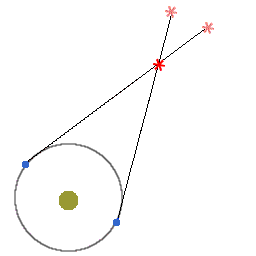Let's see how the parallax of an object varies with distance.
- One partner takes the meterstick and places the pencil vertically at the 50 cm mark. The other partner places the "zero" end of the meterstick against her/his chin, holding it out horizontally. This partner then alternates opening and closing each eye, noting how the pencil moves against specific background objects.
- Have your partner move the pen half of the original distance (to 25 cm). When you alternate opening and closing each eye does the pen appear to move more or less than before? Try to quantify how much more or less (twice as much? one-third as much? etc.).
- Now, have your lab partner move the pen twice the original distance to you, to approximately the end of the meterstick. When you alternate opening and closing each eye does the pen appear to move more or less than before? Try to quantify how much more or less (twice as much? one-third times as much? etc.).
Here is a look at the approximate relationship between distance and parallax from a different viewpoint, from above the observer.
 |
 |
The distance d2 is twice the distance d1. Does it qualitatively appear that angle a2 is one-half of a1?
When the distance is large enough that the parallax angle is very small, the parallax angle is proportional to the inverse of the distance (1/d). Conversely, if we can measure the parallax angle, we know that the distance to the object is proportional to the inverse of that angle.
There is a limit at which parallax becomes ineffective. This occurs when the parallax angle is so small that you can't see a change from one eye to the other. This distance is effectively infinity. You and your partner can find your personal infinity by taking the pencil farther and farther away from the observer until the parallax becomes undetectable.
One of you should take the role of "observer" while the other walks straight away, holding the pencil out at arm's length, stopping every meter or so. The observer should alternate opening and closing each eye as the partner stops. How far away are you from each other when the pencil stops moving relative to even more distant objects?
What can you determine about the usefulness of parallax at different distances?
- A satellite orbiting high above the Earth.
- A telescope on the Moon.
- A satellite in Jupiter's orbit.
- A satellite in Pluto's orbit.
